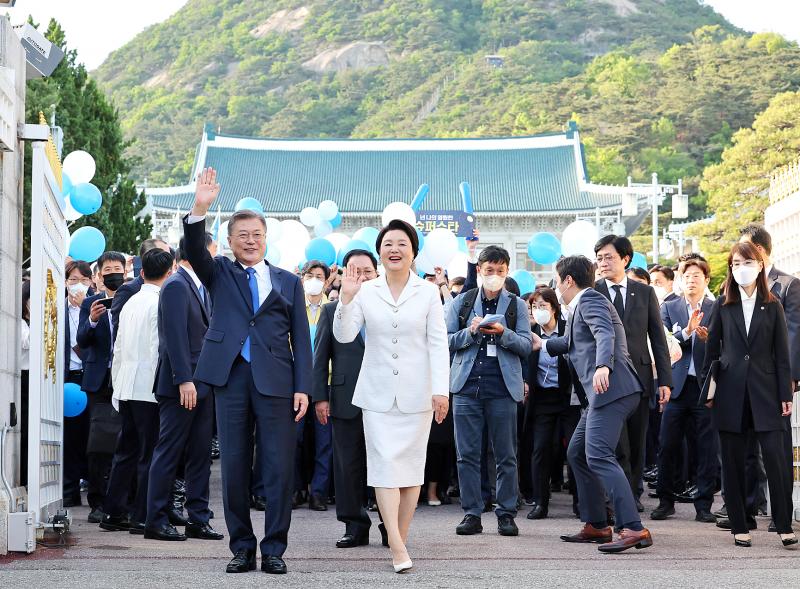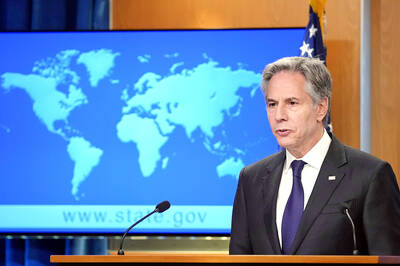South Korea’s departing liberal president yesterday defended his policy of engaging North Korea, saying in his farewell speech that he hoped efforts to restore peace and denuclearization on the Korean Peninsula would continue.
Moon Jae-in leaves office today following a single five-year term, handing over presidential power and responsibilities to conservative Yoon Suk-yeol, who has accused him of being “subservient” to North Korea and promised to take a tougher stance on its nuclear program.
“Peace is the condition for our survival and prosperity. I heartily hope that efforts to resume dialogue between South and North Korea and establish denuclearization and peace would continue,” Moon said in the nationally televised speech.

Photo: EPA-EFE
When Moon — a dove who favors greater rapprochement between the rival Koreas — took office in 2017, he found little room to maneuver diplomatically because of North Korea’s torrid run of nuclear and missile tests.
However, he eventually seized an opportunity to reconcile with Pyongyang when North Korean leader Kim Jong-un abruptly reached out to Seoul and Washington in early 2018 for talks on the future of its advancing nuclear arsenal.
Kim first sent his powerful sister to South Korea for talks with Moon and to let her to attend the opening ceremony of the Winter Olympics in South Korea in February 2018.
The two Korean leaders met three times for summits later in 2018, taking steps to lower tensions at the border and allowing rare exchange programs involving singers, basketball teams and others.
Moon also lobbied hard to broker now-stalled nuclear diplomacy between Kim and then-US president Donald Trump.
However, after the North Korea-US diplomacy collapsed in 2019, Moon faced withering criticism that his engagement policy only helped North Korea buy time and perfect its weapons program in the face of US-led sanctions.
Pyongyang eventually urged Moon not to interfere in its dealings with the US and unleashed crude insults on him.
In his last speech, Moon claimed his government helped ease the danger of war on the Korean Peninsula and raise hopes for peace through diplomacy.
“The reason why we failed to move forward further wasn’t because we lacked efforts and a determination to do that. There was a barrier that we can’t overcome only with our determination. It’s a barrier that we should overcome,” Moon said, without clarifying what the obstacle was.
Last month, Moon and Kim exchanged their final official letters expressing hope for improved bilateral relations.
However, some experts say the way North Korea described the letters, in which it highlighted Moon’s vow to continue campaigning for Korean reunification even after leaving office, reflected its intent to divide public opinion in South Korea and discourage Seoul’s new government from taking a hard line toward Pyongyang.
During a massive military parade in Pyongyang three days after the letter exchange was announced, Kim pledged to speed nuclear weapons development and threatened to use them proactively if provoked. In recent months, Kim’s military has also been test-launching a spate of missiles targeting South Korea, Japan and the mainland US.
Some experts say Kim aims to rattle Yoon’s incoming government while modernizing his weapons arsenal and pressuring the US into relaxing sanctions.
South Korean officials say North Korea also appears to be preparing for its first nuclear test since 2017.
Nearly half of China’s major cities are suffering “moderate to severe” levels of subsidence, putting millions of people at risk of flooding, especially as sea levels rise, according to a study of nationwide satellite data released yesterday. The authors of the paper, published by the journal Science, found that 45 percent of China’s urban land was sinking faster than 3mm per year, with 16 percent at more than 10mm per year, driven not only by declining water tables, but also the sheer weight of the built environment. With China’s urban population already in excess of 900 million people, “even a small portion

UNSETTLING IMAGES: The scene took place in front of TV crews covering the Trump trial, with a CNN anchor calling it an ‘emotional and unbelievably disturbing moment’ A man who doused himself in an accelerant and set himself on fire outside the courthouse where former US president Donald Trump is on trial has died, police said yesterday. The New York City Police Department (NYPD) said the man was declared dead by staff at an area hospital. The man was in Collect Pond Park at about 1:30pm on Friday when he took out pamphlets espousing conspiracy theories, tossed them around, then doused himself in an accelerant and set himself on fire, officials and witnesses said. A large number of police officers were nearby when it happened. Some officers and bystanders rushed

Beijing is continuing to commit genocide and crimes against humanity against Uyghurs and other Muslim minorities in its western Xinjiang province, U.S. Secretary of State Antony Blinken said in a report published on Monday, ahead of his planned visit to China this week. The State Department’s annual human rights report, which documents abuses recorded all over the world during the previous calendar year, repeated language from previous years on the treatment of Muslims in Xinjiang, but the publication raises the issue ahead of delicate talks, including on the war in Ukraine and global trade, between the top U.S. diplomat and Chinese

HYPOCRISY? The Chinese Ministry of Foreign Affairs yesterday asked whether Biden was talking about China or the US when he used the word ‘xenophobic’ US President Joe Biden on Wednesday called for a hike in steel tariffs on China, accusing Beijing of cheating as he spoke at a campaign event in Pennsylvania. Biden accused China of xenophobia, too, in a speech to union members in Pittsburgh. “They’re not competing, they’re cheating. They’re cheating and we’ve seen the damage here in America,” Biden said. Chinese steel companies “don’t need to worry about making a profit because the Chinese government is subsidizing them so heavily,” he said. Biden said he had called for the US Trade Representative to triple the tariff rates for Chinese steel and aluminum if Beijing was